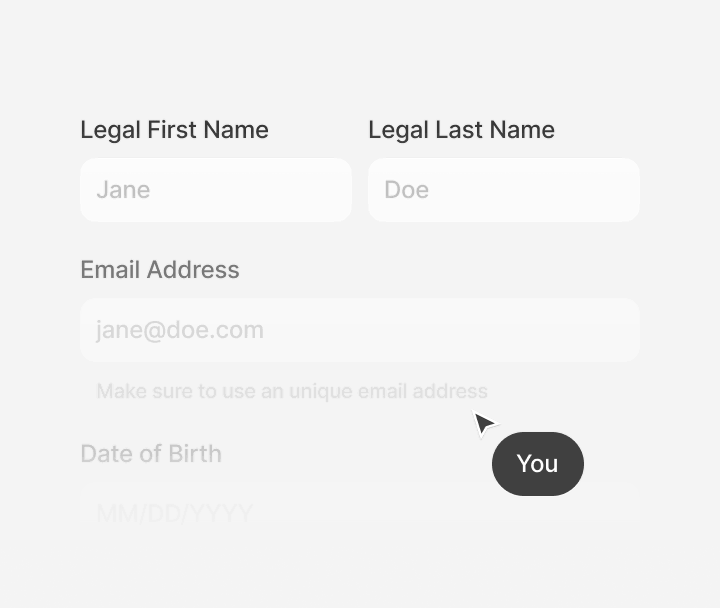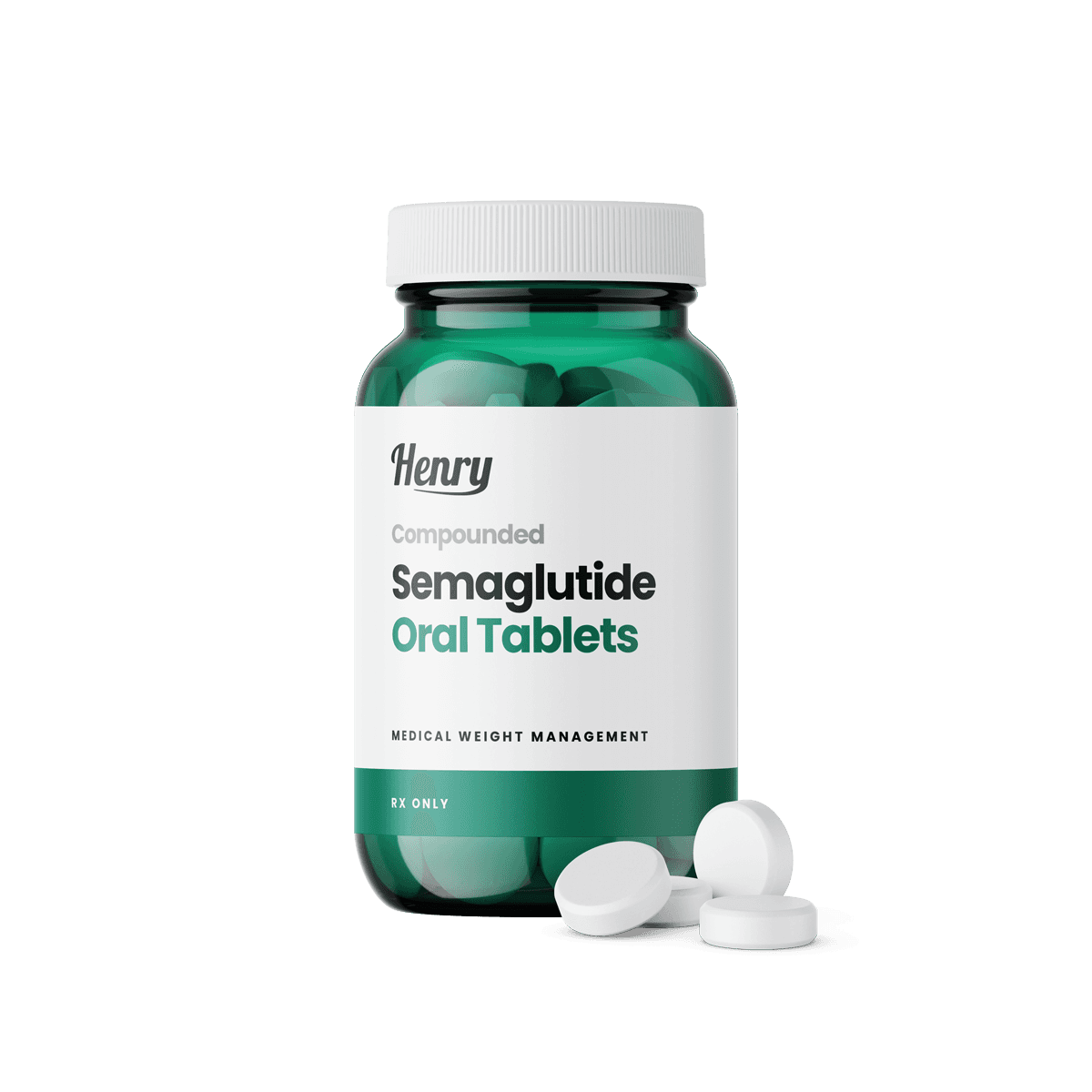
If prescribed, your subscription includes:
Healthcare
Provider Visits
Medication and
Supplies
Shipping
to Your Door
Flat Monthly
Fee

If prescribed, your subscription includes:
Healthcare
Provider Visits
Medication and
Supplies
Shipping
to Your Door
Flat Monthly
Fee

If prescribed, your subscription includes:
Healthcare
Provider Visits
Medication and
Supplies
Shipping
to Your Door
Flat Monthly
Fee
Compounded oral semaglutide is a once-daily GLP-1 medication available as a dissolving tablet or sublingual drops placed under your tongue. It is designed to curb appetite and reduce cravings, aiding in weight management.

Compounded oral semaglutide is a once-daily GLP-1 medication available as a dissolving tablet or sublingual drops placed under your tongue. It is designed to curb appetite and reduce cravings, aiding in weight management.

Compounded oral semaglutide is a once-daily GLP-1 medication available as a dissolving tablet or sublingual drops placed under your tongue. It is designed to curb appetite and reduce cravings, aiding in weight management.

Your Journey Starts with a Free Evaluation
No-obligation, personalized assessment from a Henry Meds healthcare provider.
Personalized Attention: A one-on-one consultation with a healthcare provider to discuss your unique health profile, goals, and questions.
Medical Eligibility Check: Determination if compounded semaglutide is suitable for you based on your goals and health history.
Zero Financial Risk: No upfront fees — pay only if you're prescribed medication.

Your Journey Starts with a Free Evaluation
No-obligation, personalized assessment from a Henry Meds healthcare provider.
Personalized Attention: A one-on-one consultation with a healthcare provider to discuss your unique health profile, goals, and questions.
Medical Eligibility Check: Determination if compounded semaglutide is suitable for you based on your goals and health history.
Zero Financial Risk: No upfront fees — pay only if you're prescribed medication.

Your Journey Starts with a Free Evaluation
No-obligation, personalized assessment from a Henry Meds healthcare provider.
Personalized Attention: A one-on-one consultation with a healthcare provider to discuss your unique health profile, goals, and questions.
Medical Eligibility Check: Determination if compounded semaglutide is suitable for you based on your goals and health history.
Zero Financial Risk: No upfront fees — pay only if you're prescribed medication.

How Henry Works
Interested in compounded Semaglutide? Get started with a free, no-obligation evaluation.

Medical Forms
Share your medical details — takes less than 5 minutes

Meet with a Healthcare Provider
Speak with a healthcare provider to determine if treatment is right for you

Receive Medication
If prescribed, medication and supplies mailed straight to your door
Payment is only due if prescribed medication during your free evaluation.
How Henry Works
Interested in compounded Semaglutide? Get started with a free, no-obligation evaluation.

Medical Forms
Share your medical details — takes less than 5 minutes

Meet with a Healthcare Provider
Speak with a healthcare provider to determine if treatment is right for you

Receive Medication
If prescribed, medication and supplies mailed straight to your door
Payment is only due if prescribed medication during your free evaluation.
How Henry Works
Interested in compounded Semaglutide? Get started with a free, no-obligation evaluation.

Medical Forms
Share your medical details — takes less than 5 minutes

Meet with a Healthcare Provider
Speak with a healthcare provider to determine if treatment is right for you

Receive Medication
If prescribed, medication and supplies mailed straight to your door
Payment is only due if prescribed medication during your free evaluation.
Overcome Weight Management Roadblocks
Henry offers the weight management support you've been looking for.

Medically Supervised Weight Management Treatments
Weight management is personal. Your care should be, too. Henry Meds healthcare providers offer professional, individualized support to help you reach your health and lifestyle goals.
1-1 Video Telehealth Visits
Unlimited telehealth visits from the comfort of your own space keep the focus solely on you — without distractions. No commuting, noisy waiting rooms, or privacy concerns.
Professional, Affordable Care
Quality healthcare, without the hassle of insurance — that's Henry Meds. Experience personalized treatment for a flat monthly fee.
Overcome Weight Management Roadblocks
Henry offers the weight management support you've been looking for.

Medically Supervised Weight Management Treatments
Weight management is personal. Your care should be, too. Henry Meds healthcare providers offer professional, individualized support to help you reach your health and lifestyle goals.
1-1 Video Telehealth Visits
Unlimited telehealth visits from the comfort of your own space keep the focus solely on you — without distractions. No commuting, noisy waiting rooms, or privacy concerns.
Professional, Affordable Care
Quality healthcare, without the hassle of insurance — that's Henry Meds. Experience personalized treatment for a flat monthly fee.
Overcome Weight Management Roadblocks
Henry offers the weight management support you've been looking for.

Medically Supervised Weight Management Treatments
Weight management is personal. Your care should be, too. Henry Meds healthcare providers offer professional, individualized support to help you reach your health and lifestyle goals.
1-1 Video Telehealth Visits
Unlimited telehealth visits from the comfort of your own space keep the focus solely on you — without distractions. No commuting, noisy waiting rooms, or privacy concerns.
Professional, Affordable Care
Quality healthcare, without the hassle of insurance — that's Henry Meds. Experience personalized treatment for a flat monthly fee.



What Henry Prescribes
Our goal is to provide access to the most effective medication to the people who need it most. Based on your medical history that may include:
Compounded Semaglutide
Compounded Semaglutide
Compounded Semaglutide
Daily Dissolving Tablet
Daily Dissolving Tablet
Daily Dissolving Tablet
Henry offers compounded medications.
Semaglutide is prescribed to help qualified patients lose and maintain weight loss in combination with diet and exercise. Compounded medications are not FDA-approved, but are prescribed by licensed healthcare providers based on individual patient needs.
Tablets are placed on the tongue and dissolve with no needles.
Henry offers compounded medications.
Semaglutide is prescribed to help qualified patients lose and maintain weight loss in combination with diet and exercise. Compounded medications are not FDA-approved, but are prescribed by licensed healthcare providers based on individual patient needs.
Tablets are placed on the tongue and dissolve with no needles.
Henry offers compounded medications.
Semaglutide is prescribed to help qualified patients lose and maintain weight loss in combination with diet and exercise. Compounded medications are not FDA-approved, but are prescribed by licensed healthcare providers based on individual patient needs.
Tablets are placed on the tongue and dissolve with no needles.
Your clinician will make a treatment decision based on your medical history and overall health after the completion of a telehealth consultation. Important safety information.
Your clinician will make a treatment decision based on your medical history and overall health after the completion of a telehealth consultation. Important safety information.



Other Non-Sublingual GLP-1 Weight Loss Programs
Other Non-Sublingual
GLP-1 Weight Loss Programs
Compounded
Semaglutide
Weekly Injections
As low as $147 per month
Semaglutide is prescribed to help qualified patients lose and maintain weight loss in combination with diet and exercise. Compounded medications are not FDA-approved, but are prescribed by licensed healthcare providers based on individual patient needs.
Your clinician will make a treatment decision based on your medical history and overall health after the completion of a telehealth consultation. Important safety information.
Tailored Treatment.
Medically Supervised.

Dr. Steven Peacock
Doctor of Osteopathy
Chief Medical Officer

Dr. Crystal Jacovino
Endocrinologist
Medical Director

Dr. Elizabeth Lowden
Endocrinologist
Medical Director

Kaedi Fehlberg
Nurse Practitioner
Clinical Team Manager

Evan Johnson
Physician Assistant
Clinical Team Manager

Hee Jin Cayetano
Physician Assistant
Registered Dietitian

Trace Owens
Nurse Practitioner

Rae Beltinck
Health & Wellness Manager
Tailored Treatment.
Medically Supervised.

Dr. Steven Peacock
Doctor of Osteopathy
Chief Medical Officer

Dr. Crystal Jacovino
Endocrinologist
Medical Director

Dr. Elizabeth Lowden
Endocrinologist
Medical Director

Kaedi Fehlberg
Nurse Practitioner
Clinical Team Manager

Evan Johnson
Physician Assistant
Clinical Team Manager

Hee Jin Cayetano
Physician Assistant
Registered Dietitian

Trace Owens
Nurse Practitioner

Rae Beltinck
Health & Wellness Manager
Tailored Treatment.
Medically Supervised.

Dr. Steven Peacock
Doctor of Osteopathy
Chief Medical Officer

Dr. Crystal Jacovino
Endocrinologist
Medical Director

Dr. Elizabeth Lowden
Endocrinologist
Medical Director

Kaedi Fehlberg
Nurse Practitioner
Clinical Team Manager

Evan Johnson
Physician Assistant
Clinical Team Manager

Hee Jin Cayetano
Physician Assistant
Registered Dietitian

What is Compounded Semaglutide?
Compounded Semaglutide is patient-specific medication prescribed by a licensed healthcare provider based on a medical assessment and compounded in a 503(A) Compounding Pharmacy or 503(B) Outsourcing Facility.
Compounded medications do not undergo pre-market review or an FDA-approval process. They may differ in efficacy, safety, risk, and side-effect profiles from commercially available or FDA-approved drugs. Data from clinical trials on FDA-approved medications should not be used to make assessments related to compounded medications.
Henry Meds exclusively works with licensed compounding pharmacies in the United States.

What is Compounded Semaglutide?
Compounded Semaglutide is patient-specific medication prescribed by a licensed healthcare provider based on a medical assessment and compounded in a 503(A) Compounding Pharmacy or 503(B) Outsourcing Facility.
Compounded medications do not undergo pre-market review or an FDA-approval process. They may differ in efficacy, safety, risk, and side-effect profiles from commercially available or FDA-approved drugs. Data from clinical trials on FDA-approved medications should not be used to make assessments related to compounded medications.
Henry Meds exclusively works with licensed compounding pharmacies in the United States.

What is Compounded Semaglutide?
Compounded Semaglutide is patient-specific medication prescribed by a licensed healthcare provider based on a medical assessment and compounded in a 503(A) Compounding Pharmacy or 503(B) Outsourcing Facility.
Compounded medications do not undergo pre-market review or an FDA-approval process. They may differ in efficacy, safety, risk, and side-effect profiles from commercially available or FDA-approved drugs. Data from clinical trials on FDA-approved medications should not be used to make assessments related to compounded medications.
Henry Meds exclusively works with licensed compounding pharmacies in the United States.
Frequently Asked Questions
Who is eligible for a free evaluation?
New patients interested in compounded Semaglutide products may schedule a free evaluation to determine eligibility for treatment. The patient will not be charged unless prescribed medication. If prescribed, patients will be charged the first monthly subscription fee for the plan selected during sign up.
How does Henry work?
Henry is designed to be more than a telehealth platform, but still simple for our patients. You can start treatment in three easy-steps. 1) Complete a medical intake and (if necessary) have lab work done to verify a medical need for treatment. 2) Speak to your new healthcare provider through a telehealth (audio-visual) appointment. 3) If medically appropriate, receive your medication in the mail every 30-days, or 60-days, or 90-days from a mail order pharmacy provider (depending on your provider’s decision). We want to enable you to form a long-term connection with Henry so that we can provide ongoing care for your specific condition. With that in mind, Henry is designed for patients seeking long-term care.
How much does Henry Cost?
It’s only $249 per month. That includes everything you need, from your online appointment to your medication. Multi-month pricing options may offer discounts but require a commitment to the selected term. If you want to have your order filled at a local pharmacy instead of through Henry Meds’ network, please note that the local pharmacy may not honor the low price. Most patients save over $1,000 per month by filling their order with Henry Meds.
How often will I receive a shipment?
Your membership cost includes a shipment every 60-days or 90-days depending on the product and shipping source, if medically approved. If you would like to receive monthly shipments, we offer alternative programs for an additional $100 per month. Most patients choose to utilize our 90-day option for the convenience and cost savings.
What if I need to cancel?
You can cancel any time in your customer account or by contacting our support team. Canceling before your contract term has ended will require payment of your remaining contract balance. Patients who are unable to continue the multi-month pricing program due to health-related issues, as determined by a healthcare provider, may cancel their commitment without incurring further charges. Contact our support team to learn more.
Is this real medication?
Yes, all medications are made in a State Board of Pharmacy licensed 503(A) compounding pharmacy, or 503(B) Outsourcing Facility. We work with pharmacies licensed in all 50 states using only the highest-quality ingredients. Medically approved clients are typically offered prescription (Liraglutide/Cyanocobalamin) or (Semaglutide/Cyanocobalamin) injections. These are slowly absorbed by the body over a day or week to help reduce appetite and cravings.
How much weight will I lose?
Actual weight lost is dependent on a number of factors but many Henry Meds patients lose around 5% of their initial body weight. Over 12 weeks, it can be as high as 10%. This equates to a weight loss of 10–20 pounds for a 200 pound person. Everyone is different though and the most successful patients also work hard to make diet and lifestyle changes. Healthy weight loss is often defined as 1-2lbs per week. Extreme weight loss is not a medically desired effect.
How soon will I receive my medication?
After your provider has prescribed a GLP-1 Medication, or another weight loss option, we send your prescription to a licensed compounding pharmacy. It typically takes 3-4 business days for the pharmacy to process the order which is then shipped via 2-Day shipping. Overall, most patients receive their medication within 8-10 business days from when they speak to their provider. Please note, patients in California may experienced increased fulfillment time due to additional compound testing requirements.
What is the age range for treatment?
Patients seeking treatment for GLP-1 programs need to be at at least 18 years of age and no older than 80.
Frequently Asked Questions
Who is eligible for a free evaluation?
New patients interested in compounded Semaglutide products may schedule a free evaluation to determine eligibility for treatment. The patient will not be charged unless prescribed medication. If prescribed, patients will be charged the first monthly subscription fee for the plan selected during sign up.
How does Henry work?
Henry is designed to be more than a telehealth platform, but still simple for our patients. You can start treatment in three easy-steps. 1) Complete a medical intake and (if necessary) have lab work done to verify a medical need for treatment. 2) Speak to your new healthcare provider through a telehealth (audio-visual) appointment. 3) If medically appropriate, receive your medication in the mail every 30-days, or 60-days, or 90-days from a mail order pharmacy provider (depending on your provider’s decision). We want to enable you to form a long-term connection with Henry so that we can provide ongoing care for your specific condition. With that in mind, Henry is designed for patients seeking long-term care.
How much does Henry Cost?
It’s only $249 per month. That includes everything you need, from your online appointment to your medication. Multi-month pricing options may offer discounts but require a commitment to the selected term. If you want to have your order filled at a local pharmacy instead of through Henry Meds’ network, please note that the local pharmacy may not honor the low price. Most patients save over $1,000 per month by filling their order with Henry Meds.
How often will I receive a shipment?
Your membership cost includes a shipment every 60-days or 90-days depending on the product and shipping source, if medically approved. If you would like to receive monthly shipments, we offer alternative programs for an additional $100 per month. Most patients choose to utilize our 90-day option for the convenience and cost savings.
What if I need to cancel?
You can cancel any time in your customer account or by contacting our support team. Canceling before your contract term has ended will require payment of your remaining contract balance. Patients who are unable to continue the multi-month pricing program due to health-related issues, as determined by a healthcare provider, may cancel their commitment without incurring further charges. Contact our support team to learn more.
Is this real medication?
Yes, all medications are made in a State Board of Pharmacy licensed 503(A) compounding pharmacy, or 503(B) Outsourcing Facility. We work with pharmacies licensed in all 50 states using only the highest-quality ingredients. Medically approved clients are typically offered prescription (Liraglutide/Cyanocobalamin) or (Semaglutide/Cyanocobalamin) injections. These are slowly absorbed by the body over a day or week to help reduce appetite and cravings.
How much weight will I lose?
Actual weight lost is dependent on a number of factors but many Henry Meds patients lose around 5% of their initial body weight. Over 12 weeks, it can be as high as 10%. This equates to a weight loss of 10–20 pounds for a 200 pound person. Everyone is different though and the most successful patients also work hard to make diet and lifestyle changes. Healthy weight loss is often defined as 1-2lbs per week. Extreme weight loss is not a medically desired effect.
How soon will I receive my medication?
After your provider has prescribed a GLP-1 Medication, or another weight loss option, we send your prescription to a licensed compounding pharmacy. It typically takes 3-4 business days for the pharmacy to process the order which is then shipped via 2-Day shipping. Overall, most patients receive their medication within 8-10 business days from when they speak to their provider. Please note, patients in California may experienced increased fulfillment time due to additional compound testing requirements.
What is the age range for treatment?
Patients seeking treatment for GLP-1 programs need to be at at least 18 years of age and no older than 80.
Frequently Asked Questions
Who is eligible for a free evaluation?
New patients interested in compounded Semaglutide products may schedule a free evaluation to determine eligibility for treatment. The patient will not be charged unless prescribed medication. If prescribed, patients will be charged the first monthly subscription fee for the plan selected during sign up.
How does Henry work?
Henry is designed to be more than a telehealth platform, but still simple for our patients. You can start treatment in three easy-steps. 1) Complete a medical intake and (if necessary) have lab work done to verify a medical need for treatment. 2) Speak to your new healthcare provider through a telehealth (audio-visual) appointment. 3) If medically appropriate, receive your medication in the mail every 30-days, or 60-days, or 90-days from a mail order pharmacy provider (depending on your provider’s decision). We want to enable you to form a long-term connection with Henry so that we can provide ongoing care for your specific condition. With that in mind, Henry is designed for patients seeking long-term care.
How much does Henry Cost?
It’s only $249 per month. That includes everything you need, from your online appointment to your medication. Multi-month pricing options may offer discounts but require a commitment to the selected term. If you want to have your order filled at a local pharmacy instead of through Henry Meds’ network, please note that the local pharmacy may not honor the low price. Most patients save over $1,000 per month by filling their order with Henry Meds.
How often will I receive a shipment?
Your membership cost includes a shipment every 60-days or 90-days depending on the product and shipping source, if medically approved. If you would like to receive monthly shipments, we offer alternative programs for an additional $100 per month. Most patients choose to utilize our 90-day option for the convenience and cost savings.
What if I need to cancel?
You can cancel any time in your customer account or by contacting our support team. Canceling before your contract term has ended will require payment of your remaining contract balance. Patients who are unable to continue the multi-month pricing program due to health-related issues, as determined by a healthcare provider, may cancel their commitment without incurring further charges. Contact our support team to learn more.
Is this real medication?
Yes, all medications are made in a State Board of Pharmacy licensed 503(A) compounding pharmacy, or 503(B) Outsourcing Facility. We work with pharmacies licensed in all 50 states using only the highest-quality ingredients. Medically approved clients are typically offered prescription (Liraglutide/Cyanocobalamin) or (Semaglutide/Cyanocobalamin) injections. These are slowly absorbed by the body over a day or week to help reduce appetite and cravings.
How much weight will I lose?
Actual weight lost is dependent on a number of factors but many Henry Meds patients lose around 5% of their initial body weight. Over 12 weeks, it can be as high as 10%. This equates to a weight loss of 10–20 pounds for a 200 pound person. Everyone is different though and the most successful patients also work hard to make diet and lifestyle changes. Healthy weight loss is often defined as 1-2lbs per week. Extreme weight loss is not a medically desired effect.
How soon will I receive my medication?
After your provider has prescribed a GLP-1 Medication, or another weight loss option, we send your prescription to a licensed compounding pharmacy. It typically takes 3-4 business days for the pharmacy to process the order which is then shipped via 2-Day shipping. Overall, most patients receive their medication within 8-10 business days from when they speak to their provider. Please note, patients in California may experienced increased fulfillment time due to additional compound testing requirements.
What is the age range for treatment?
Patients seeking treatment for GLP-1 programs need to be at at least 18 years of age and no older than 80.
